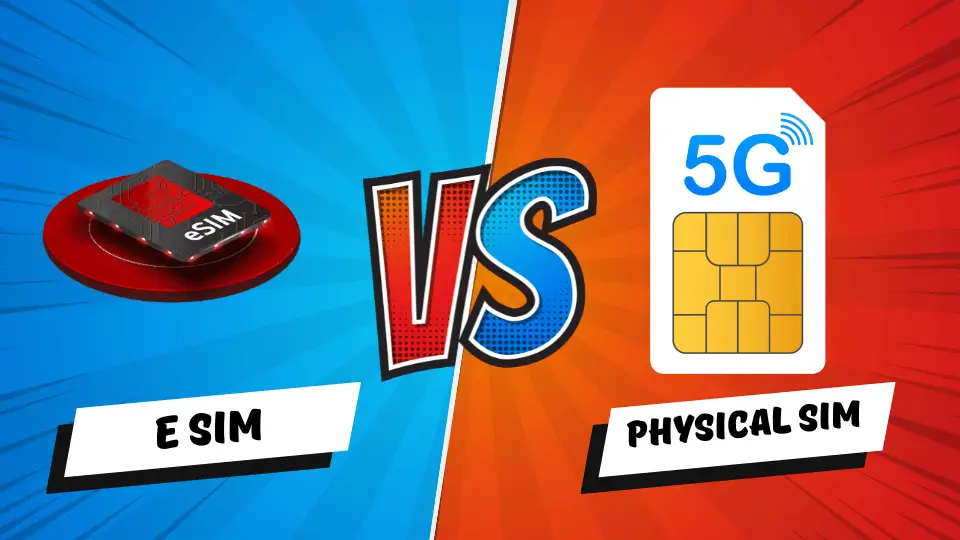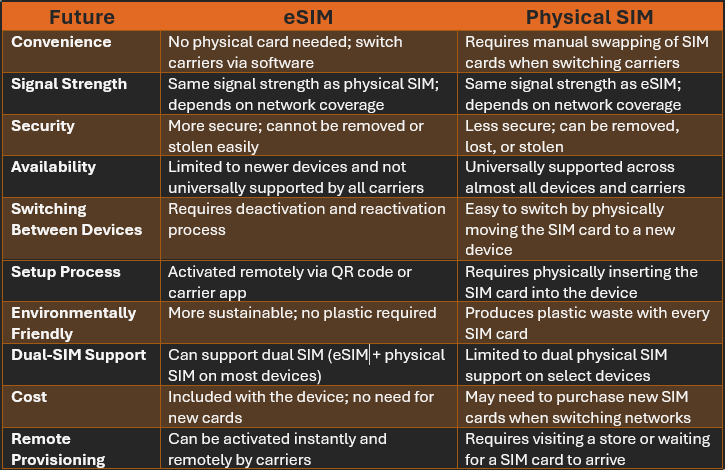In the rapidly evolving world of mobile technology, one debate has gained significant attention: eSIM vs Physical SIM. As smartphones and other devices embrace cutting-edge advancements, many users wonder which option suits them better.
This article delves into the differences between eSIM and physical SIM, comparing their benefits, signal strength, and overall user experience.
What is an eSIM?
An eSIM is an (embedded SIM) card that is incorporated into a device. Unlike a conventional SIM card, an eSIM is pre-installed into the equipment. This means there is no need to slot or replace the card on one’s phone.
Such technology is used to manufacture the newest smartphones, wearable devices, and tablets. It provides the user with a highly mobile and convenient way of selecting the most advantageous network.
What is a Physical SIM?
A physical SIM ( Subscriber Identity Module) has been around for decades and is the small card you often insert into your mobile phone device and sometimes into your tablet to connect to a mobile network.
However, there have been new developments and changes, and one of these changes is the eSim or virtual SIM card. Although a physical SIM card has been the norm for decades now, it has its limitations.
Switching carriers can be a hassle if you have to change the card, and it can be inconvenient. Misplacing, damaging, or tampering with your SIM can also cause havoc as you cannot easily access your network.
eSIM vs Physical SIM: Key Differences

1.Convenience and Flexibility
- eSIM: There are a few simple reasons why eSIM is much more convenient. Since eSIM is essentially a virtual SIM that exists as a piece of software in your phone, there are no additional physical objects that you need to attach or detach. You can easily switch devices just using your eSIM profile and add multiple network profiles as you like.
- Physical SIM: The traditional SIM card, established around three decades ago, is a small card inserted into your phone. To switch to another mobile operator, you need to remove the SIM card from the phone and input it into another smartphone. It is a simple process, but if you frequently change carriers or travel internationally, it can be a bit of a hassle.
Winner: eSIM for its flexibility in managing multiple carriers without needing physical swaps.
2.Signal Strength and Network Performance
- eSIM: The signal strength on an eSIM is as reliable as that of a physical SIM. Because it runs on the same telecommunication towers and infrastructure, there is no difference. Some people even report that they tend to have better connectivity because eSIM set-up is easy and swift when used on supported devices.
- Physical SIM: Signal strength and network performance on a physical SIM largely depend on the network provider and the region. In well-covered regions, the same works exceptionally well on a physical SIM. However, in most cases, the experience on an eSIM is mostly the same as a physical SIM.
Winner: Tie. Both offer similar signal strength as they connect to the same network infrastructure.
3.Security
- eSIM: eSIMs are more secure as they are built into the device and cannot be removed or lost. Even if thieves steal your phone, you can lock or wipe the eSIM remotely, making it almost impossible for anyone to misuse it.
- Physical SIM: The physical SIM card can be lost or stolen; you must try deactivating it. A thief can remove your SIM and use it in another phone if they wish to
Winner: eSIM, for being more secure and less vulnerable to theft or misuse.
4.Availability and Compatibility
- eSIM: eSIM cards are growing in popularity, but they are only suitable for some mobile phones and providers. Although most newer mobile phones and devices, such as newer iPhones, Google Pixels, and Samsung Galaxy models, work with eSIM cards, not all of them and service providers do. Thus, whether you can use an eSIM card typically depends on where you live and the phone you use.
- Physical SIM: Physical SIM cards are readily available and compatible with all devices and service providers in most parts of the world. If you reside in an area where eSIM cards or service providers might not work for you from a provider, you will undoubtedly benefit from using a physical SIM card on your trusted device.
Winner: Physical SIM for widespread availability and compatibility.
5.Switching Between Devices
- eSIM: While switching devices with an eSIM is quite simple, it is still slightly more complicated than sliding a SIM card in and out of a phone. Because eSIMs are embedded in the device and cannot be removed, you need to deactivate the eSIM on one device before activating it on another. However, someone has streamlined these steps, so they are no longer time-consuming.
- Physical SIM: Switching between devices is incredibly easy with a physical SIM because you can remove the card from one phone and then insert it into another. The process is immediate, and there are no additional steps.
Winner: Physical SIM for the ease of switching between devices.
Differences between eSIM and Physical SIM

Benefits of eSIM vs Physical SIM
eSIM benefits:
- No physical swapping: perfect for travellers or those managing multiple lines.
- Supports dual-SIM functionality: many phones allow you to use an eSIM and a physical SIM.
- Environmentally friendly: because they don’t require plastic, eSIMs are more sustainable.
- Remote provisioning: Carriers can activate your eSIM remotely, making setup fast and hassle-free.
Physical SIM benefits:
- Compatibility: for those who have old devices.
- Simplicity: for those who already use the current process of swapping devices.
- Ease of use: Physical SIMs are simple to install and use without requiring any software configurations or downloads.
- No learning curve: For users who are familiar with traditional SIM cards, there’s no need to learn new processes or deal with software-based configurations.
eSIM vs Physical SIM: Which is Better for You?
Whether an eSIM or a physical SIM is the best choice depends largely on your lifestyle, devices, and specific needs. If you appreciate convenience, security, and flexibility, especially an eSIM will likely be the best option.
With it, you can physically handle your mobile plan without touching the SIM card.
However, if you live in a location where an eSIM is not supported, and you like your old phone if you travel a lot or switch carriers, or if you prefer simplicity and switching your SIM card between devices, then a physical SIM will be better for you for now.
eSIM Smartphone list
| Apple | Samsung | Others | |
| iPhone 16 series (iPhone 16, 16 Plus, 16 Pro, 16 Pro Max) | Samsung Galaxy S24 series (S24, S24+, S24 Ultra) | Pixel 9, Pixel 9 Pro, and Pixel 9 Pro XL | Motorola Edge+ (2024) |
| iPhone 15 series (iPhone 15, 15 Plus, 15 Pro, 15 Pro Max) | Samsung Galaxy S23 series (S23, S23+, S23 Ultra) | Google Pixel 8 series (Pixel 8, Pixel 8 Pro) | Motorola Razr+ (2024) |
| iPhone 14 series (iPhone 14, 14 Plus, 14 Pro, 14 Pro Max) | Samsung Galaxy S21 series (S21, S21+, S21 Ultra) | Google Pixel 7 series (Pixel 7, Pixel 7 Pro) | Huawei P40 series (P40, P40 Pro) |
| iPhone 13 series (iPhone 13, 13 mini, 13 Pro, 13 Pro Max) | Samsung Galaxy Z Fold 5 | Google Pixel 6 series (Pixel 6, Pixel 6 Pro, Pixel 6a) | Huawei Mate 40 Pro |
| iPhone 12 series (iPhone 12, 12 mini, 12 Pro, 12 Pro Max) | Samsung Galaxy Z Flip 5 | Google Pixel 5 | Oppo Find X3 Pro (Limited regions) |
| iPhone 11 series (iPhone 11, 11 Pro, 11 Pro Max) | Samsung Galaxy Z Fold (2-5) | Google Pixel 4 series (Pixel 4, Pixel 4a, Pixel 4 XL) | Microsoft Surface Duo 2 |
| iPhone XS, XS Max, XR | Samsung Galaxy Z Flip (1-5 | Google Pixel 3 series (Pixel 3, Pixel 3 XL) – (eSIM only in certain regions) | Xiaomi 12 & 12 Pro,Xiaomi 13 & 13 Pro |
| iPhone SE (2020 and 2022 models) | Samsung Galaxy Note 20 Ultra | Sony Xperia (1 IV,5 IV,10 IV,1 III,5 III) | |
| iPad Pro 12.9-inch (3rd-6th generation) | Huawei Mate 60 series | ||
| iPad (6th-10th generation) | Xiaomi 12T Pro | ||
| iPad Air (3rd-5th generation) | Oppo Find X6 Pro | ||
| iPad mini (5th&6th generation) | Motorola Razr 5G |
Conclusion
There are relative advantages on both sides of eSIM vs. physical SIM. Far and away, the eSIM is the future of connectivity in terms of its convenience, security, and eco-consciousness.
However, the physical SIM is a time-tested, reliable solution that works. In some countries, not enough devices use eSIMs yet, so the advantage of having a physical SIM is that not enough phones have adopted eSIMs to render the other side of the comparison irrelevant.
Assuming that, in some time, most devices will adopt the eSIM as the standard, as most advanced countries will do in several years, the gap will close, making a choice the device owner’s preference rather than a technological split. Both systems are war-tech grade, and no losers are in that battle.
What is an eSIM?
An eSIM is a digital SIM card embedded in your device, eliminating the need for a physical card.
How does a physical SIM card work?
A physical SIM is a small card you insert into your device to connect to a mobile network.
Can I use eSIM and physical SIM together?
Yes, many devices support both eSIM and physical SIM simultaneously.
Is eSIM available everywhere?
eSIM is widely available but check with your device and carrier for support in your region.
How do I switch carriers with an eSIM?
You can switch carriers via your device’s settings without needing to change a physical card.





